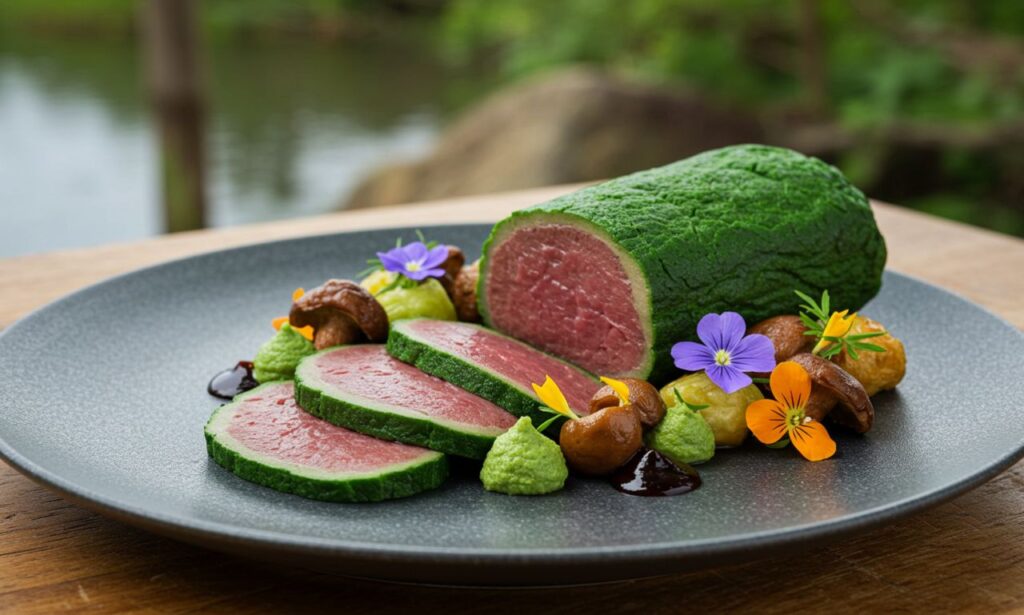In the world of gourmet foods, certain names immediately evoke curiosity. Jade venison is one such term — an exotic and evocative phrase that blends the richness of venison with the mystique of culinary artistry. For chefs, food connoisseurs, and health-conscious eaters alike, this unique ingredient is rapidly gaining recognition for its taste, nutritional profile, and cultural significance.
Though not as widely known as traditional venison, jade venison represents a growing niche in the culinary market — combining wild game traditions with refined, often Asian-inspired, cooking methods. This article explores the many facets of jade venison, from sourcing and preparation to health benefits and gourmet appeal.
What is Jade Venison?
At its core, jade venison refers to high-quality venison cuts prepared with techniques that preserve the meat’s natural flavors while enhancing its appearance and texture. The “jade” reference typically speaks to the vibrant, almost luminous finish achieved through specific marinating or cooking processes — often incorporating green herbs, teas, or jade-colored sauces that impart both flavor and visual allure.
Unlike typical game meats, jade venison is prized for its balance of leanness, tenderness, and the subtle infusion of earthy, herbal notes that align it closely with Asian or fusion cuisines.
The Origins of JadeVenison in Culinary Traditions
Though the term may seem modern, the concept of enhancing venison with herbal or jade-colored infusions has roots in ancient culinary practices. In regions where venison was a prized delicacy — such as China, Japan, and parts of Europe — cooks often used jade-hued ingredients like green tea, bamboo, and herbs to elevate the dish beyond mere sustenance.
Today’s jade venison honors those traditions while incorporating contemporary cooking methods, from sous-vide to precision grilling.
How Jade Venison is Prepared
The preparation of jade venison is both an art and a science. Typically, the process begins with the careful selection of young, tender cuts, often from deer species known for their mild, less gamey flavors. These cuts are marinated in mixtures that might include:
-
Green tea infusions
-
Fresh jade herbs like shiso or coriander
-
Seaweed extracts
-
Light miso or soy-based glazes
Slow cooking, steaming, or flash-searing techniques are commonly used to preserve moisture while achieving the desired texture and visual presentation.
Nutritional Benefits of Jade Venison
Lean, high in protein, and rich in iron, jade venison stands out as one of the healthiest red meat options available. It’s naturally low in fat and cholesterol, making it ideal for those seeking heart-healthy protein sources without sacrificing flavor.
Key health benefits include:
-
High protein for muscle repair
-
Iron for energy and blood health
-
Zinc for immune support
-
B vitamins for overall vitality
Thanks to its lean nature, venison also fits well into diets like keto, paleo, and Mediterranean.
Jade Venison and Sustainability
One reason jade venison is garnering attention is its sustainability profile. Wild and farm-raised deer are generally more environmentally friendly than cattle, requiring less land, water, and feed. Ethical sourcing practices ensure that venison supports both ecological balance and local farming economies.
Choosing this meat can contribute to reduced carbon footprints compared to more conventional red meats.
Cultural Significance of Jade Venison
In many Asian cultures, jade symbolizes purity, health, and longevity. When infused into cuisine — whether symbolically through color or literally via ingredients — it elevates the dish beyond nutrition, connecting it to wellness traditions. Jvenison often features in ceremonial meals, festivals, and high-end dining experiences where symbolism matters as much as taste.
Popular Dishes Featuring Jade Venison
Creative chefs worldwide are incorporating jade venison into a variety of mouthwatering dishes. Some standouts include:
-
Jade Venison Tataki: Lightly seared with a green tea marinade, served with microgreens.
-
Herb-Infused Jade Carpaccio: Paper-thin slices dressed with jade oil and citrus.
-
Green Curry Jade Stew: A fusion of Thai and Japanese influences, balancing spice and herbal notes.
-
Jade Skewers: Grilled with miso-jade glaze, offering a smoky yet refreshing bite.
The Flavor Profile of Jade
Expect a flavor that’s milder than traditional venison yet richer than beef. Jade typically carries notes of forest herbs, subtle umami from its marinades, and a tender mouthfeel akin to premium wagyu beef. Its unique infusion methods often impart a delicate herbal or tea-like aroma, adding depth to each bite.
Pairing Wine and Sides with Jade Venison
Pairing is crucial to fully enjoy jade. Light to medium-bodied red wines with earthy undertones complement its flavors — think Pinot Noir or a refined Grenache. For white wine lovers, an aged Chardonnay or a dry Riesling can also balance the herbal components well.
Ideal sides include:
-
Lightly steamed vegetables
-
Jasmine or wild rice
-
Seaweed salad
-
Fermented greens like kimchi
These accompaniments highlight the freshness and complexity of the dish.
Where to Source Jade Venison
Finding jade isn’t as simple as visiting your local supermarket. Specialty butchers, high-end grocers, and online exotic meat suppliers typically carry it. Look for vendors who emphasize ethical sourcing and freshness. Farm-to-table restaurants with a focus on wild game may also feature it on seasonal menus.
Cooking Tips for Jade Venison at Home
When preparing jade at home, remember these key tips:
-
Marinate overnight for depth of flavor.
-
Avoid overcooking; medium-rare retains tenderness.
-
Use a meat thermometer for precision.
-
Rest the meat post-cooking to lock in juices.
Experimenting with herbs and light marinades can yield surprising results, turning a simple dinner into a gourmet experience.
Jade in Fine Dining Trends
In high-end culinary circles, jade is becoming synonymous with innovation. Its unique preparation methods and fusion flavors align with the modern diner’s desire for sustainable, story-driven food. Expect to see it increasingly featured in tasting menus and chef’s tables worldwide.
Comparing Jade Venison to Other Exotic Meats
When compared to meats like wild boar, bison, or elk, jade often comes out ahead for its tenderness and subtle flavor. While bison may offer a heartier bite, and boar a more pronounced gamey taste, jade venison remains refined, light, and versatile.
Health-Conscious Dining and Jade Venison
For those managing dietary concerns like heart health, cholesterol, or inflammation, jade offers a superior alternative to fattier red meats. Its nutrient profile supports a balanced, healthy diet without sacrificing culinary pleasure.
Global Influence of Venison in Fusion Cuisine
Chefs globally are adopting jade in fusion dishes, blending Western techniques with Eastern flavors. Its adaptability makes it a star ingredient in everything from tapas to ramen, illustrating the increasing globalization of fine dining.
Is Venison Worth the Hype?
For those seeking a memorable dining experience that fuses tradition, health, and artistry, the answer is a resounding yes. Jade represents not just a meal but a story on a plate — one of heritage, innovation, and thoughtful preparation.
Conclusion
In a culinary landscape increasingly driven by both health and experience, jade shines as a testament to thoughtful eating. It bridges ancient tradition with modern innovation, offering diners a sustainable, nutritious, and utterly delicious option. Whether enjoyed in a fine dining restaurant or crafted carefully at home, venison promises a unique and memorable addition to any table.






